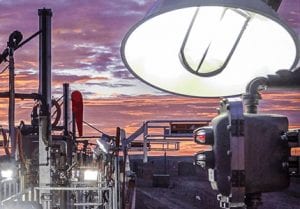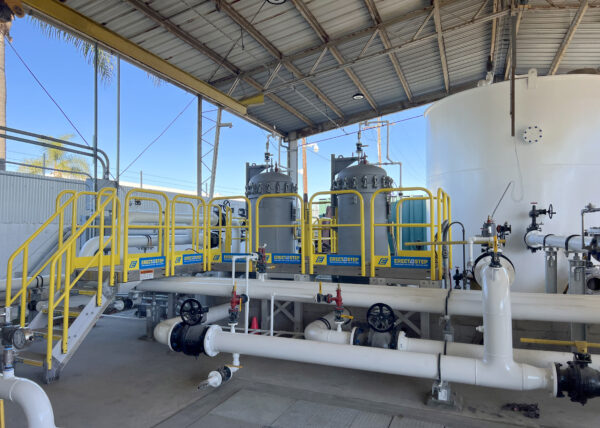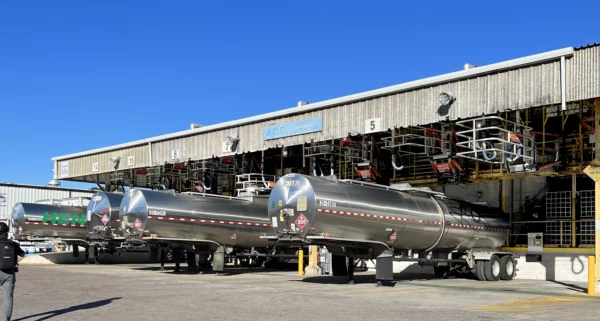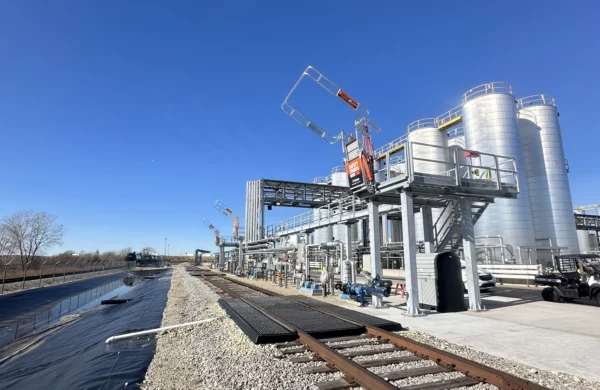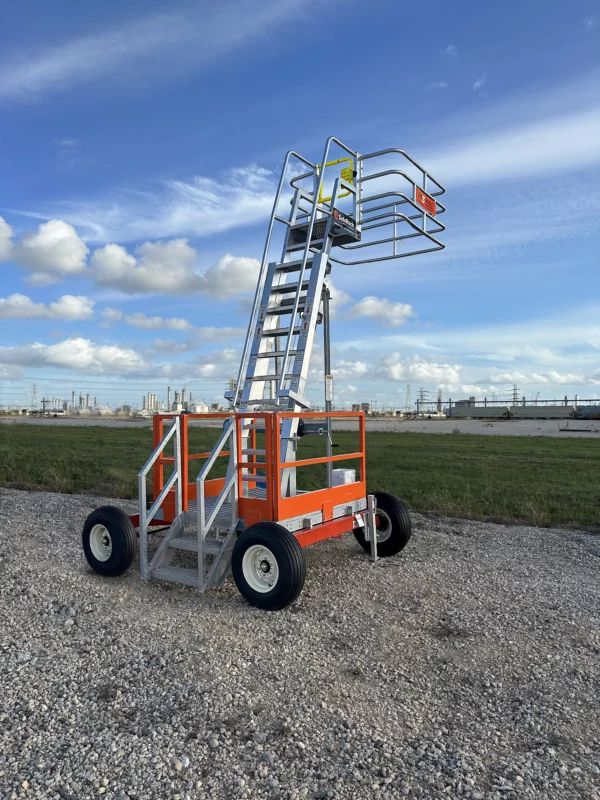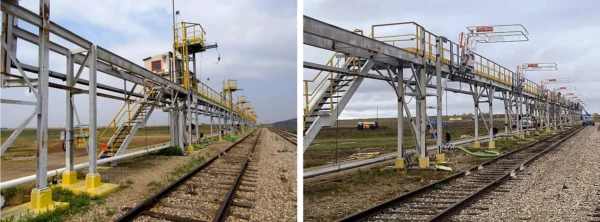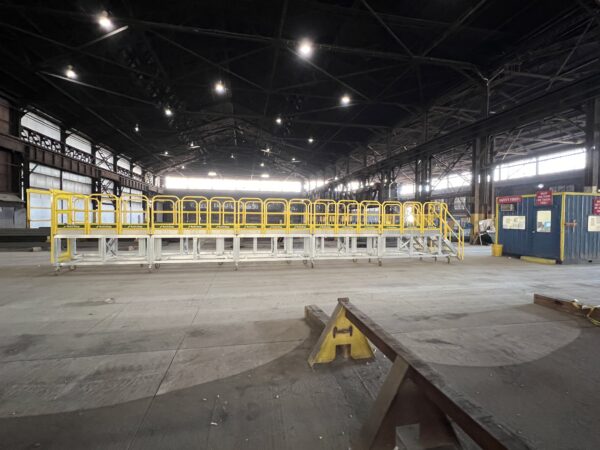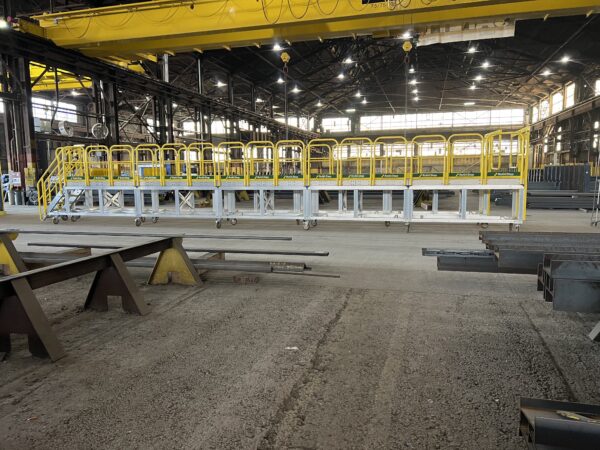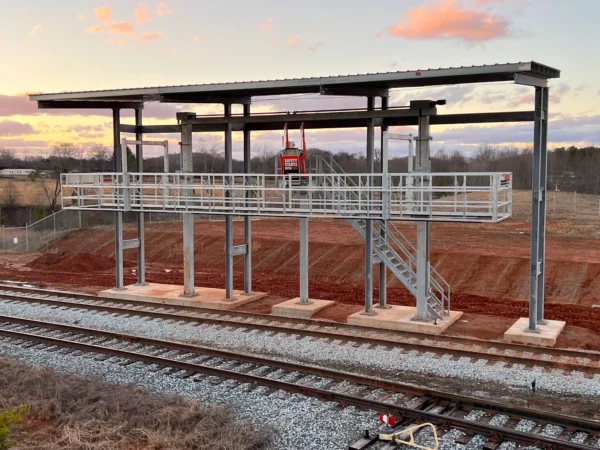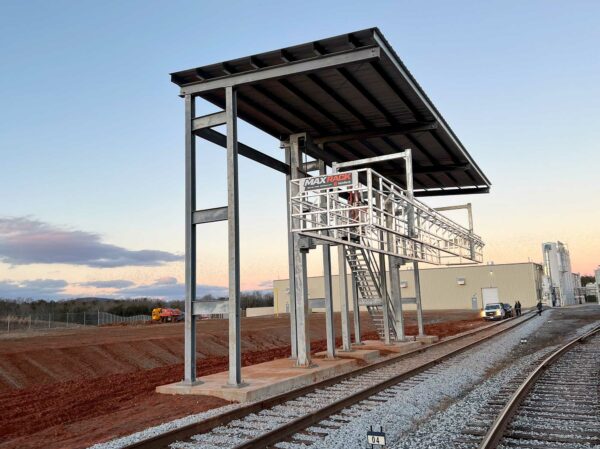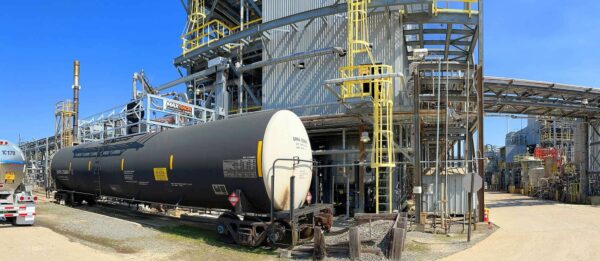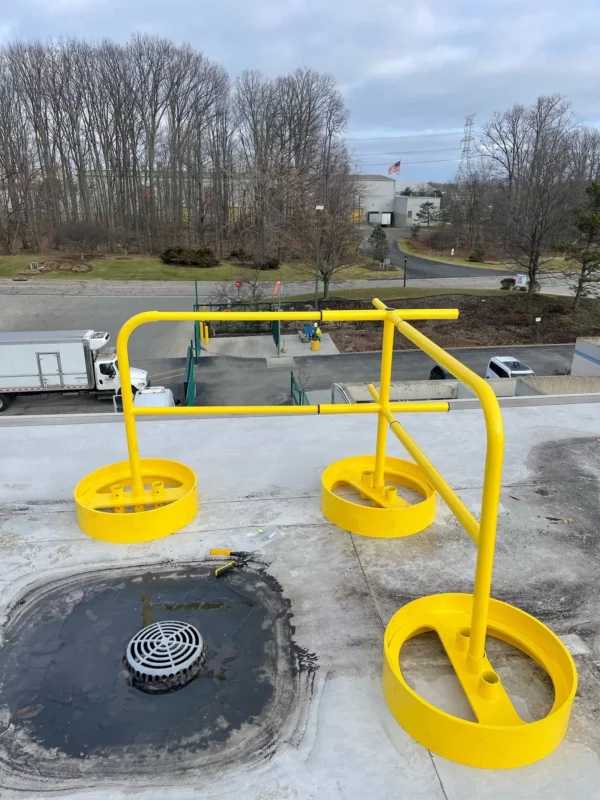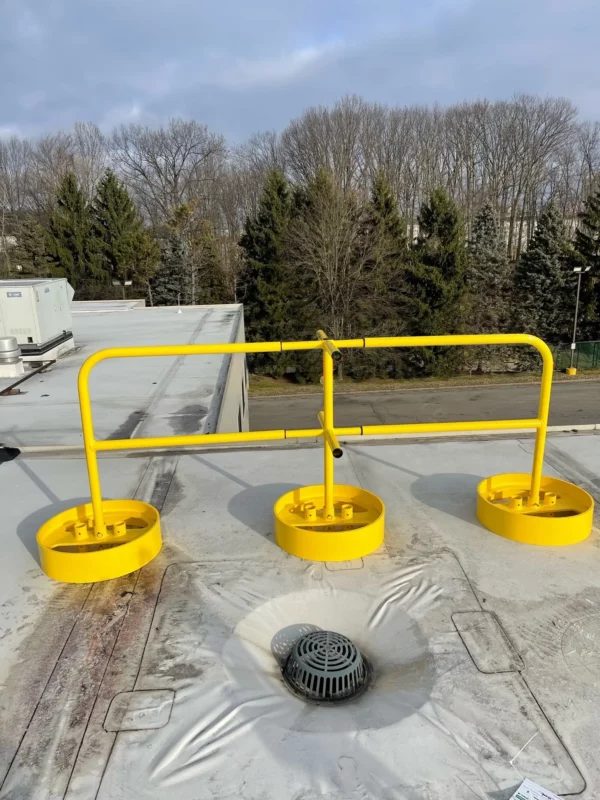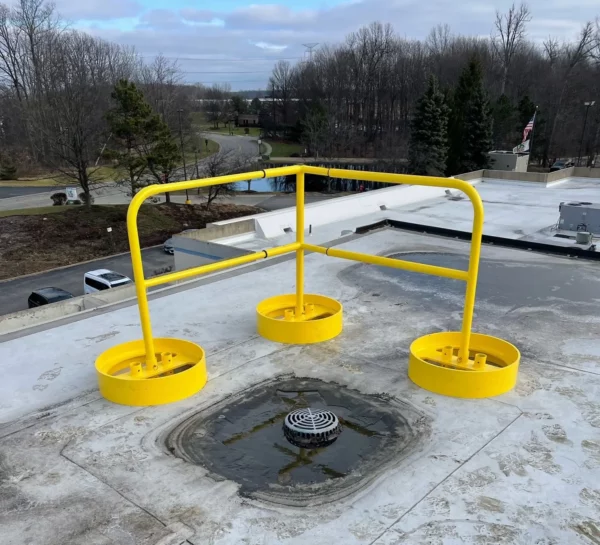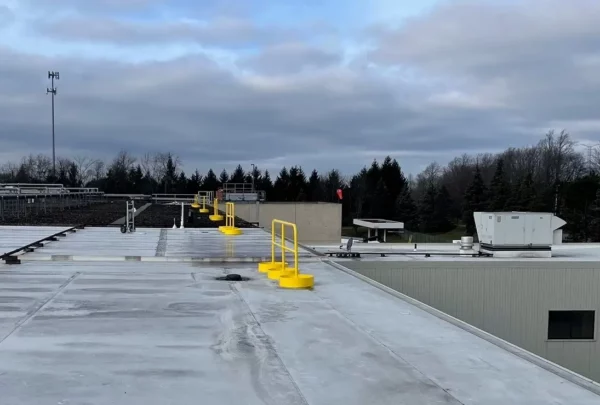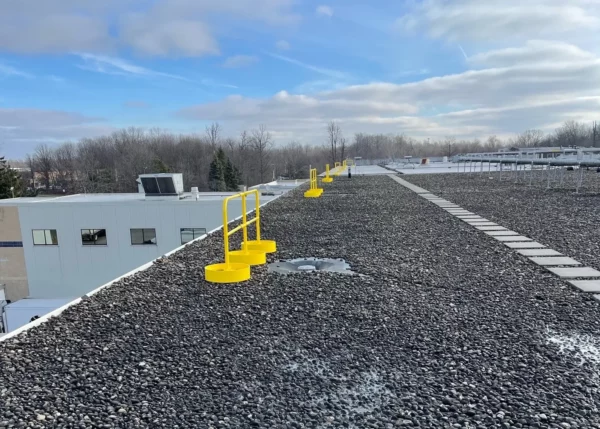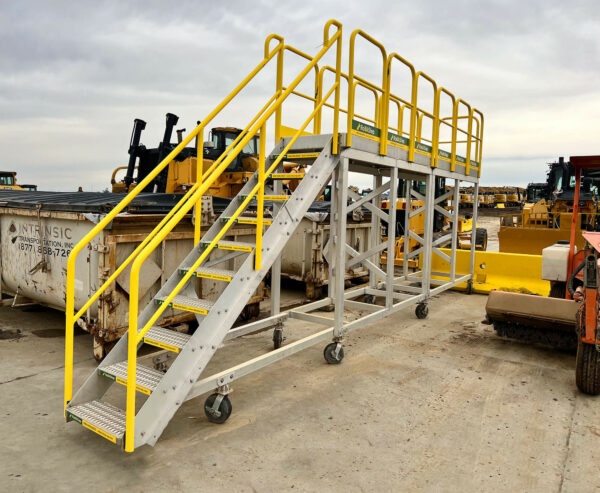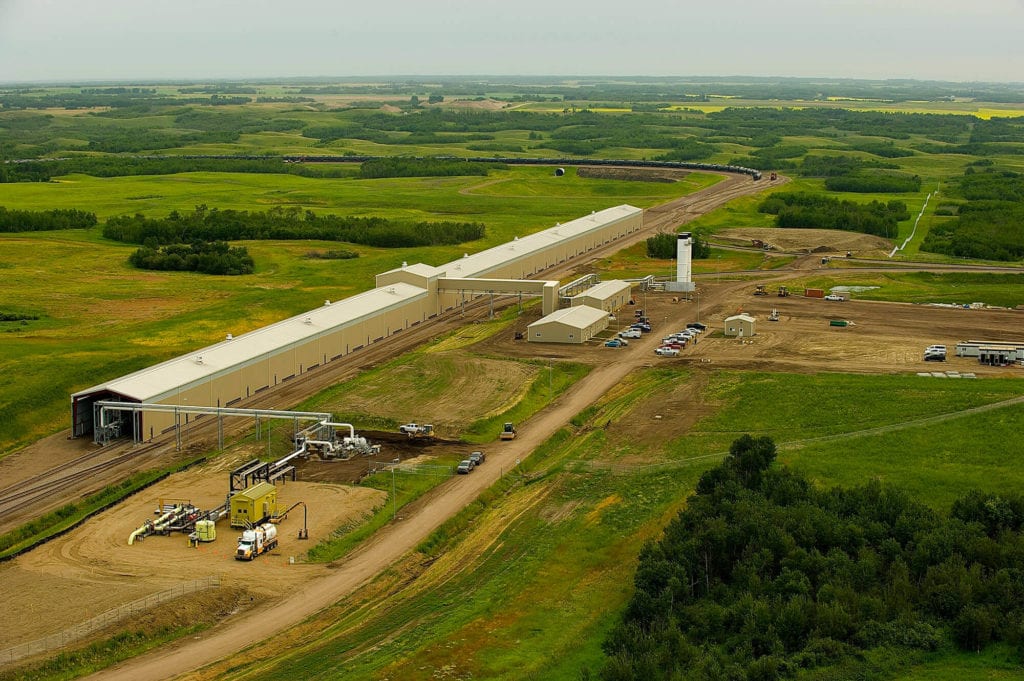Get a quote, configure a custom safety solution or ask a question. We're here to help!








- Spill ContainmentMore …Loading Safety CagesMore …
SafeRack Worldwide
We pride ourselves on one-on-one customer service. When you call SafeRack, we'll be there to answer your questions with a combined experience of 400+ years.
Select your region below.- View Products
- Railcar & Truck Loading Platforms
- Gangways & Loading Ramps
- Stairs, Platforms & Ladders
- Mobile Ladders & Platforms
- Loading Arms & Fluid Transfer
- Safety Gates & Traffic Control
- Aviation & Aerospace Access
- Marine Access & Loading
- Grounding & Monitoring
- Spill Containment
- Loading Safety Cages
- Transloaders & Skids
- Shelters & Canopies
- Fall Protection
- Terminal & Speciality
Home / Industries / Bulk Chemical Loading / Phosphorus OxychloridePhosphorus Oxychloride (POC13) Handling Design, Loading, and Installation.
Although no two Phosphorus Oxychloride (un)loading solutions will be identical, the product itself determines much of the critical design criteria that will ensure that optimum safety and productivity can work together in harmony.
What is Phosphorus Oxychloride? Phosphorus Oxychloride, also known as Phosphoryl Oxychloride is a colorless to slightly cloudy, oily fuming liquid with a strong odor that’s used as a chlorinating agent in gasoline additives, plasticizers, hydraulic fluids, and pesticides.
In the United States, Phosphorus Oxychloride is a “tight-fill” (closed-loop) (un)loading operation and is loaded into rail cars via chemical hoses, stainless steel or 3′ PTFE lined loading arms. Phosphorus Oxychloride if not handled properly can cause serious injuries and Personal Protective Equipment (PPE) is required. Additionally, because operators are on top of the vehicles during the loading process, robust, well-designed fall prevention is essential to ensure increased throughput, without compromising operator safety.
Phosphorus Oxychloride is typically shipped in 10,000 gallon DOT-103 rubber lined, insulated, or non-insulated tank cars with safety valves. The rails cars themselves are ~ 9′ outside diameter with an overall length of ~45′ to 50′, with a 6′ x 6′ center opening or off-set crash box openings.








Question, Get a Quote, Live Demo or Request an On-Site Visit
Our experts simplify the complex
View Full TextTank truck (un)loading procedures are similar to railcar applications with the trailers meeting established DOT requirements for transporting aluminum sulfate or other similar commodities. Approved DOT trailers include MC 307 or low pressure chemical ISO containers. Trailers and ISO’s are typically bottom unloaded. An extension pipe with two valves is flanged to the top of the trailer.
All trailers must be equipped with pressure relief valves, and trailers with bottom outlets must be equipped with remote controlled stop valves.
Typical Phosphorus Oxychloride Loading Platform
Quote or discuss your installation.
Start by selecting loading application"*" indicates required fields
Below are some of the loading and unloading solutions for illustrative purposes only. Our experts will work with you and your team for a custom solution to suit your needs.
Phosphorus Oxychloride Loading Arms

Phosphorus Oxychloride is typically loaded into railcars or tank trucks via boom supported stainless steel, PTFE lined loading arms or chemical hoses with flanged end connections. The arm or hose will have a top inlet with a control valve to ensure that it is self-draining after use and is supported along the length of a mechanical loading arm to improve handling; this is known as a by-pass arm. You can install one liquid and one vapor arm, or mount both the liquid and vapor hoses on one by-pass arm. For unloading, typically you would use a rigid self-draining stainless steel or PTFE lined loading arm with ChemRaz (FFKM), Kalrez, or PTFE seals. Purge lines can be fitted to the arm, for nitrogen purging. Additional features such as parking latches with proximity sensors can be incorporated into the total system to ensure the arm is correctly stowed when not in use before any rail movement can occur.
Loading Gangways and Safety Cages


A wider access gangway (48″-60″ is preferable) as it helps improve access and egress to and from the vessel. In addition, a wider gangway will reduce the risk of the operator’s PPE getting caught, torn or damaged, and will improve productivity and safety. Powered gangway solutions are also an option, with both hydraulic and pneumatic solutions being commonly used. Each gangway will be fitted with a two-rail safety cage for the railcar crash box. This will be a centered 6’x6’ safety cage to sit directly over the cashbox. This will provide a safe, secure work environment for your operator when connected to their breathing apparatus.
GX FLAT RAMP ACCESS (FRT) GANGWAY
SafeRack’s NEW GX-FRT is a flat ramp model popular with railcars. It features a slip-resistant walk surface and, with the use of the telescoping extension, eliminates gaps on narrow railcars. Learn More

SafeRack’s GX SAS gangways use Retractalok power-assist technology allowing operators to raise or lower effortlessly, light as a feather to lift, and solid as a rock. Tested in the most critical applications, this revolutionary new gangway outperforms all others. Available in multiple lengths and widths.
Learn MoreMAXRack Elevating Safety Cage
 As an alternative to our two and four-rail safety cages, some customers prefer our MAXRack elevating safety cages. The ultimate fall prevention solution engineered to keep operators safe and productive. Designed for both trucks or railcars, and available in multiple cage lengths and widths. Safe, durable, and easy to use. MAXRack is built rock-solid with galvanized steel column supports and lifting arms (cages can be Aluminum, Galvanized, or Stainless Steel depending on application) Available in two power options – Pneumatic Air Drive and Electric Drive (Explosion and Non-Explosion Proof).
As an alternative to our two and four-rail safety cages, some customers prefer our MAXRack elevating safety cages. The ultimate fall prevention solution engineered to keep operators safe and productive. Designed for both trucks or railcars, and available in multiple cage lengths and widths. Safe, durable, and easy to use. MAXRack is built rock-solid with galvanized steel column supports and lifting arms (cages can be Aluminum, Galvanized, or Stainless Steel depending on application) Available in two power options – Pneumatic Air Drive and Electric Drive (Explosion and Non-Explosion Proof).
Learn MorePhosphorus Oxychloride Wash/Drench Showers

ANSI guidelines state that an Eye Wash/Drench Showers need to be located 10 seconds or 55’ (16.8m) from contaminants or hazardous materials. Eyewash stations need to be on the same horizontal plane with no obstructions.
Therefore, we would propose the installation of a standard combination Drench Shower/Eyewash Unit, which will save limited space and fit easily into any work environment.
Phosphorus Oxcyxhloride Spill Containment

Spill containment pans will be provided at the point of loading operations and is an essential piece of equipment in overall site safety and environmental protection. Phosphorus Oxychloride Grounding

Phosphorus Oxychloride does not burn, but it becomes highly volatile and explosive when exposed to water; therefore, industry best practice includes the grounding of all vessels before starting the (un)loading process. - Ground controllers — ensure true grounding before product flow is permitted
- Explosion-proof enclosures — meet or exceed UL, CSA, and Ex requirements
- Non-sparking tools are also recommended while working around this product
Phosphorus Oxychloride Safety Gates

Safety Gates will be installed at the top of stairs and any other openings to ensure operator safety at all times.  YellowGate Safety Gates
YellowGate Safety GatesSafeRack’s line of industrial safety gates is the most flexible product on the market with the ability span openings between 16” and 36” and is field adjustable with nothing more than a wrench. Learn More
Phosphorus Oxychloride Options

- Lighting – Lighting both over and under the platform will be provided. For overcast days or second shifts, lighting is essential for improved safety and improved productivity.
- Platform & Canopies – Full platform canopies reduce exposure to the elements and improve the safe and productive loading operation from the operator’s perspective.
- Operator Shelter – Depending on your site requirements, consideration should be given to the requirement of an operator or guard building on the loading platform. This can be customized to meet specific site requirements.
- Wheel Chocks – Railcar Wheel Chocks provide fast blocking of all types of railcars and meet OSHA regulations to safely prevent railroad cars from moving during loading or unloading operations. This is a requirement by the Department of Homeland Security.
Personal Protective Equipment PPE Requirements
Eye/Face Protection: Wear chemical safety goggles. The use of a respiratory device to protect against the effects of fumes, dust and aerosol is also recommended.
Skin Protection: Wear chemical protective clothing e.g. gloves, aprons, boots. Coveralls or long sleeve shirts and pants in some operations. Wear a chemical protective, full-body encapsulating suit, and self-contained breathing apparatus (SCBA). Suitable materials include: butyl rubber, neoprene rubber, Viton®, Viton®/butyl rubber, Barrier® – PE/PA/PE, Silver Shield® – PE/EVAL/PE, Trellchem® HPS, Trellchem® VPS, Saranex®™, Tychem® BR/LV, Tychem® Responder® CSM, Tychem® TK. The following materials should NOT be used: natural rubber, polyvinyl chloride. Recommendations are NOT valid for very thin neoprene rubber gloves (0.3 mm or less).
Respiratory Protection: Up to 3 ppm:
(APF = 10) Any chemical cartridge respirator with cartridge(s) providing protection against chlorine*; or Any supplied-air respirator*.
*Reported to cause eye irritation or damage; may require eye protection.
APF = Assigned Protection Factor
Recommendations apply only to National Institute for Occupational Safety and Health (NIOSH) approved respirators. Refer to the NIOSH pocket guide to chemical hazards for more information.
Use a local exhaust ventilation and enclosure, if necessary, to control the amount in the air. Consider using a corrosion-resistant exhaust ventilation system separate from other ventilation systems. It may be necessary to use stringent control measures such as process enclosure to prevent product release into the workplace. Use backup controls (e.g. double mechanical pump seals) to prevent the release of this material due to equipment failure. * For illustrative purposes only. Our experts will work with you and your team for a custom solution to suit your needs. Customer Reviews
 5 5Better than the competition.
5 5Better than the competition.Delivered ahead of promised schedule. Ease of operation, built to accommodate existing space and was installed in one day. We would definitely recommend, because it’s just better than the competition.
By Darrell DuVall from Maola Milk & Ice Cream on 8/12/134 5Delivered in a timely fashion.Product was delivered on the date that we were told it would be delivered, in a timely fashion. The product met our needs, and was of good quality. Our sales person was courteous and kept us well informed as to when the product would be delivered.
By Bill Mason from Marysville Gas Liquids on 9/19/13 5 5We are satisfied with our Ultratech spill containment solution
5 5We are satisfied with our Ultratech spill containment solutionI ordered your containment barrier wall. It went together very easy and the tarp snaps on the rails. It’s easy to step over to get into.
By Richard Jansen from Cornejo Corp on 5/5/215 5Great vendor, great product at a fair value.Very responsive; all who were involved were very conscientious and helpful. Solid gate and just what we were looking for to satisfy our safety audit. All staff involved were simply fantastic. Shipping was prompt and product came in in perfect condition.
By Dale Curry from Pinnacle Corrugated on 10/11/18 4 5The quality looks to be very good.
4 5The quality looks to be very good.I’d recommend your product. The quality looks to be very good.
By Gary Worthen from Schlumberger Oilfield Services on 6/28/11 5 5Faster hook up and disconnect.
5 5Faster hook up and disconnect.We plan to use the product for reduced air emissions and faster hook up and disconnect.
By Resin Manufacturing Engineer from Xerox Corporation on 4/29/15MAJOR PHOSPHORUS OXYCHLORIDE PRODUCERS WHERE WE HAVE SUCCESSFULLY EXECUTED PHOSPHORUS OXYCHLORIDE LOADING PROJECTS
Phosphorus Oxychloride 101
Things to know about Phosphorus Oxychloride
Phosphorus Oxychloride is regulated by the U.S. Department of Transportation (DOT) and is classified as a corrosive hazardous material with the DOT identification number UN 1810.
Phosphorus Oxychloride is a colorless, fuming, and highly corrosive liquid that is used in the manufacturing of agrochemicals, flame retardants, hydraulic fluids, gasoline additives and pharmaceuticals.
Only properly trained and equipped personnel should be permitted to handle chlorosulfonic acid tank cars and tank trucks. Operators should wear approved PPE equipment including impervious clothing, footwear, gloves, and goggles.
Phosphorus Oxychloride is dangerous to human health, and as a corrosive chemical, acute exposure can cause severe skin burns and eye damage. Do not breathe dust/fumes/mist/vapors as they can be fatal if inhaled. Use only outdoors, or in a well ventilated area.
First aid measures for exposure include – removing operators from the source of exposure and into fresh air. Remove contaminated clothing immediately; wash skin thoroughly with soap and water; flush eyes with tepid water for 15 minutes. If ingested do not induce vomiting, but immediately call your local poison control center. Aspiration into the lungs can cause fatal chemical pneumonitis. If ingestion has occurred, assume there is a risk of aspiration into the lungs.
POC13 will react violently with water, moisture, or steam to form Hydrogen Chloride and Phosphoric Acid. Best practice includes storing in a cool, dry environment in well sealed containers, and away from any oxidizing agents. Avoid storage near extreme heat, ignition sources, or open flame.
Phosphorus Oxychloride is corrosive to most metals including aluminum, brass, carbon, milled steel, so great care should be taken to avoid contact with these materials. However, galvanized or stainless steel is an acceptable material for construction.

Is your plant or facility compliant with ANSI, OSHA, and local safety codes? We can help!


EMERGENCY EYEWASHES / SHOWER EQUIPMENT AND THE ANSI/ISEA Z358.1 – 2014 STANDARD
Following eye contact, you must start washing with water immediately to prevent permanent damage. In the event of skin contact, you must start washing with water immediately to prevent slow-healing chemical burns.
Are you aware that ANSI guidelines state that Eye Wash/Drench Showers need to be located 10 seconds or 55′ from contaminates or hazardous materials and located on the same horizontal plane, with no obstructions? If bottom loading/unloading, an additional shower should be located at grade as well. SafeRack provides the above equipment plus much more needed to keep employees safe and expedite bulk chemical loading and unloading.
OSHA Regulation Experts – Does your existing chemical safety equipment or chemical loading systems meet OSHA’s latest requirements? SafeRack’s professional technical sales consultants are available to meet with your team to make recommendations to keep your facility in front of OSHA’s ever-changing country and region-specific standards and regulations, including lifeline and trolley beam fall arrest systems, metal stairs, and access platforms.
Why SafeRack?
The SafeRack approach is a collaborative one. Let’s call it The SafeRack Way. We have, over many years amassed a great deal of experience and understanding of the safety aspects involved in loading road tankers and railcars, as well as the behavioral habits of the operators.

Experts In Chemical Loading
- Acetic Acid
- Acetic Anhydride
- Acetonitrile
- Acrolein
- Acrylic Acid
- Acrylonitrile
- Aluminum Chloride
- Aluminum Sulfate
- Ammonia
- Ammonium Hydroxide
- Ammonium Nitrate
- Aniline
- Benzene
- Benzyl Chloride
- Bromotrifluoromethane
- Butadiene
- Carbon Dioxide
- Caustic
- Chlorine
- Chloroform
- Chlorosulfonic Acid
- DEF (Diesel Exhaust Fluid)
- Diethylene Glycol
- Dimethylformamide
- Dodecylbenzene Sulfonic Acid
- Ethanol
- Ethyl Acetate
- Ethyl Chloride
- Ethylene
- Ethylene Dichloride
- Ethylene Glycol
- Ethylene Oxide
- Ferric Chloride
- Ferrous Chloride
- Hexane
- Hydrochloric Acid
- Hydrofluoric Acid
- Hydrofluorosilicic Acid
- Hydrogen Cyanide
- Hydrogen Peroxide
- Hydrofluoric Acid
- Hypochlorous Acid
- Isopropyl Acetate
- Liquid Argon
- Liquid Nitrogen
- Liquid Oxygen
- Maleic Anhydride
- MDI
- Methanol
- Methyl Chloride
- Methyl Ethyl Ketone
- Methyl Methacrylate
- Methyl Isocyanate
- Molten Sulphur
- Nitric Acid
- Oleum
- Phenol
- Phosphoric Acid
- Phosphorus Oxychloride
- Phosphorus Trichloride
- Polypropylene
- Renewable Diesel
- Sodium Cyanide
- Sodium Hydroxide
- Sodium Hypochlorite
- Styrene Monomer
- Sulfuric Acid
- Sulfur Dioxide
- Titanium Tetrachloride
- Toluene
- Toluene Diisocyanate
- Turpenitne
- UAN (Urea Ammonium Nitrate)
- UREA
- Vinyl Acetate
- Vinyl Chloride
- Xylene
- Zinc Chloride
- Agro-Chemical
- Specialty Chemical
- Petrochemical

North America’s largest loading terminal
World-leading designer, manufacturer, and installer of truck and railcar loading platforms
As one of the primary railcar loading points, Hardisty is one of the major crude oil hubs in North America and a major origination point of pipelines that export to the United States. SCS was asked to supply and construct a SafeRack crude oil loadout terminal spanning nearly half a mile. The USD Hardisty terminal can load up to two 120-railcar unit trains per day and consists of a fixed loading rack with 62 railcar loading positions enclosed, separate control, operator, and mechanical buildings, as well as a unit train staging area and loop tracks capable of holding multiple unit trains simultaneously. SCS also supplied and installed boom-supported loading arms with supply and vapor management systems.

Quick Quote 866-761-7225
LET US DESIGN YOUR SOLUTION TODAY
Our innovative tools provide 3D visualizations and accurate quotes in minutes.
Get Help NowOrder Now 866-761-7225
Questions or Need a Quote?
Chat live with a knowledgeable and friendly safety expert now.

Bob Kashtan
Located in South Carolina

Joey Robinson
Located in South Carolina

Caelin Lacy
Located in South Carolina

Katie Kelly
Located in South Carolina

Amber Graham
Located in South Carolina






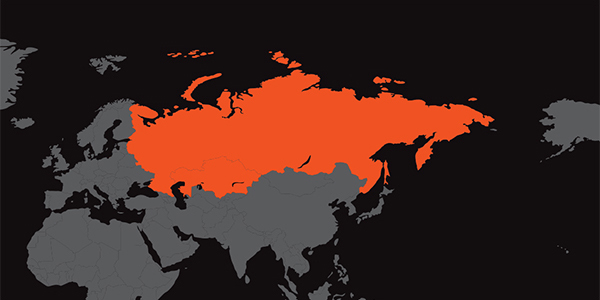
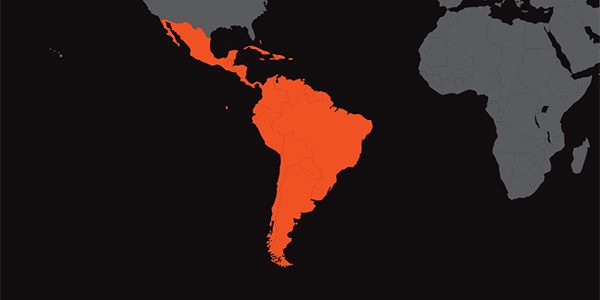




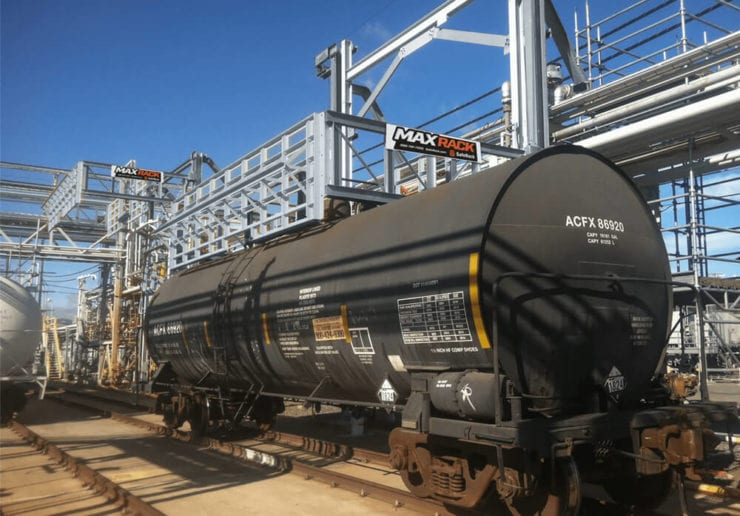

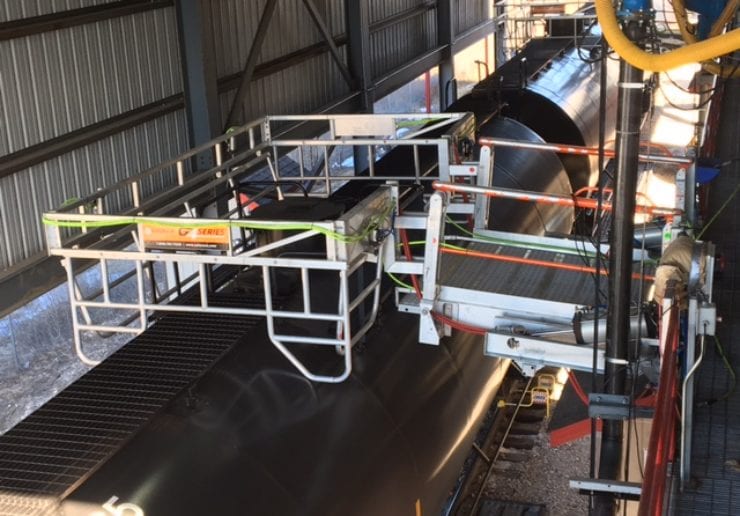

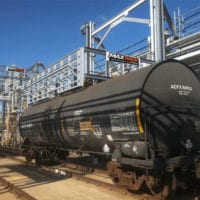
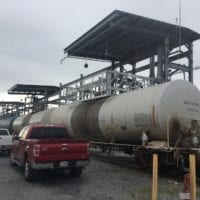
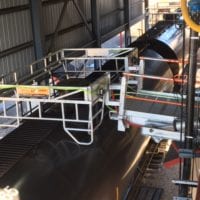


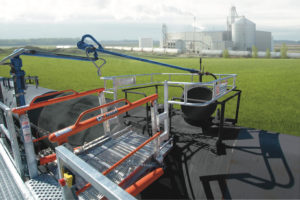
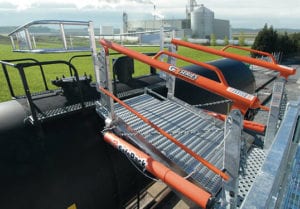
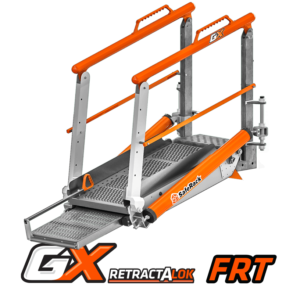
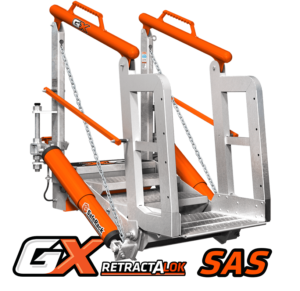
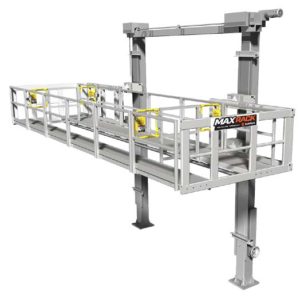 As an alternative to our two and four-rail safety cages, some customers prefer our MAXRack elevating safety cages. The ultimate fall prevention solution engineered to keep operators safe and productive. Designed for both trucks or railcars, and available in multiple cage lengths and widths. Safe, durable, and easy to use. MAXRack is built rock-solid with galvanized steel column supports and lifting arms (cages can be Aluminum, Galvanized, or Stainless Steel depending on application) Available in two power options – Pneumatic Air Drive and Electric Drive (Explosion and Non-Explosion Proof).
As an alternative to our two and four-rail safety cages, some customers prefer our MAXRack elevating safety cages. The ultimate fall prevention solution engineered to keep operators safe and productive. Designed for both trucks or railcars, and available in multiple cage lengths and widths. Safe, durable, and easy to use. MAXRack is built rock-solid with galvanized steel column supports and lifting arms (cages can be Aluminum, Galvanized, or Stainless Steel depending on application) Available in two power options – Pneumatic Air Drive and Electric Drive (Explosion and Non-Explosion Proof).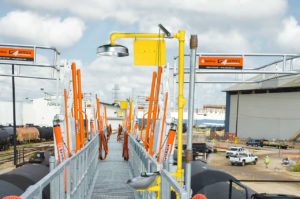
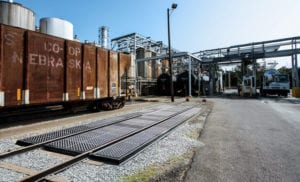
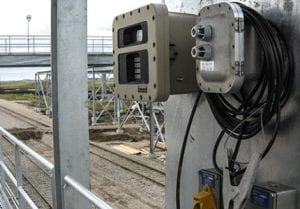
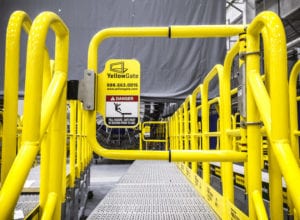
 YellowGate Safety Gates
YellowGate Safety Gates